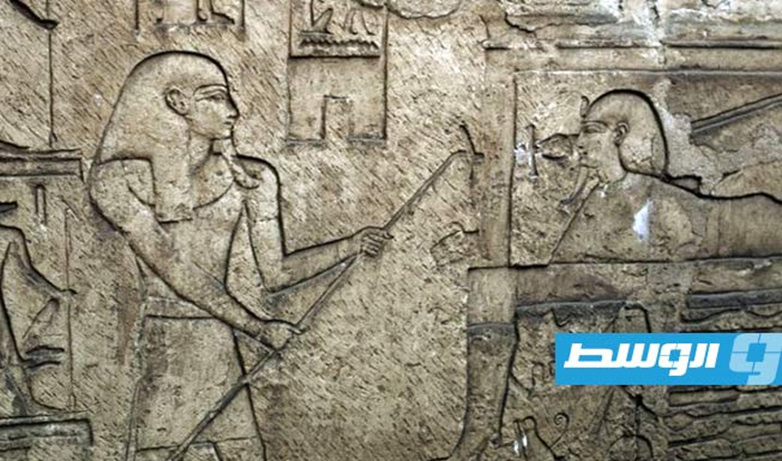“The Louvre” decides: Sheshenq of Libya is the Pharaoh of Egypt

A mural of King Sheshenq (Internet)
Although the discovery of the “Basinhour” painting, which dated the origin of Sheshenq I, Pharaoh of the 22nd Dynasty (945 BC - 924 BC), dates back to the year 1851, when it was found by the French archaeologist Auguste Mariette in the Egyptian village of Saqqara (before it was He transferred it to the Louvre Museum, where it remains to this day), stating that he is a direct descendant of the Libyan Amazigh“Mashwesh” tribes, who had settled on the outskirts of the Nile Valley Delta, around Bubastis, beginning in the 20th Dynasty. However, confirmation of the existence of this legendary pharaoh had to wait. Until the middle of the last century, when the French archaeologist Montet was able in 1940 to discover the Sheshenq tomb in an integrated copy, which miraculously escaped the tampering hands that affected other Pharaonic tombs.
As fate would have it, Sheshenq’s tomb remained protected with all its secrets and the silver arches that decorated its parts, so much so that literary prose used to call him the Silver Pharaoh. This Libyan leader who founded a legendary kingdom whose authority extended from the Libyan desert and throughout Egypt, Sudan and the Levant, and who was mentioned in the Torah (in the Book of Kings), as the king who invaded Jerusalem (Jerusalem), and to whom all the treasures of Solomon were returned.
The mention of Sheshenq resurfaces today in a heated battle between parties that see his ascription to them as national glory, and has made Libyans wake up to the fact that some of their ancestors ruled all corners of the earth, even if they did not give this much importance.
In Libya, we have continued to let down our own history. Other than the Sheshenq family’s rule of the Middle East, there was a Libyan emperor who ruled the entire world, and he was Septimius Severus, whom some people expressed great concern for erecting his statue in the capital’s square.
In his book: “Warrior Pharaohs... Diplomats and Military,” Dr. Hussein Abdel Basir explains that Sheshenq I ruled Egypt from the year 945 to the year 924 BC... and he was the beginning of the Egyptianized Libyan branch that ruled Egypt for two hundred years.
Dr. Abdel Basir points out that Sheshonq linked himself to the previous family through marriage to the daughter of the previous king, Busines II, and was able, due to his exceptional military background, to establish sovereign continuity in the rule of a major state that had rarely been achieved in history.
Many historical studies attribute “Shishenq” to the “Meshwash” tribes who were settling in the Libyan “Ahnasia”, although there are some opinions that suggest the return of these tribes to other regions of North Africa.
This is what the current controversy is based on.

In the Louvre, the news is certain.
Dr. Hafez Al-Walda, Ambassador and Permanent Representative of Libya to UNESCO, believes that, based on Basinhour’s painting (inscription), which is located in the Louvre Museum in Paris, we can know more about the origin of the dynasty and the chronology of the rule:
We find confirmation that the Meshwesh (who were in almost constant conflict with the Egyptian state), some of them of Libyan origin, are explicitly mentioned in a genealogy found on the stela (dated to the reign of Sheshonq V), where the great chiefs of the Meshwesh (including the kings of the Second Dynasty) are mentioned. The twenty) are considered to be the descendants of “Buyo Wawa of Libya.”
He stresses in this regard: “The Libyan-Amazigh origin of the Meshwesh is also indicated in their personal names (such as Osorkon, Takelot, Nimlot, Shushing, etc.) and a few non-Egyptian surnames used by these people, related to Amazigh languages.”
The Meshwesh ruled Egypt throughout the 22nd and 23rd Dynasties under the rule of powerful pharaohs such as Sheshenq I, Osorkon I, Osorkon II, Sheshenq III, and Osorkon III.
However, the mention of the Meshweesh will be absent in later sources, as some scholars believe that it is the same tribe called the Mazis or Mazikes, according to what was reported by Hecateus of Miletus, Herodotus's Chomxis, and to which the name Amazigh dates back historically.
Whatever the motives for the controversy over the lineage of Sheshonq the Libyan, perhaps what this great leader did is inspiring to us in this difficult time. This is the one who succeeded, with exceptional leadership genius, in expanding the borders of his Pharaonic kingdom, to include Egypt, Sudan, the Levant, and Libya, in one state, all of which are his homeland, and to which, in all its parts, his history and heritage belong, and perhaps from it we may draw inspiration from our dreams of “national unity,” uniting our present diaspora.
Source : websites

